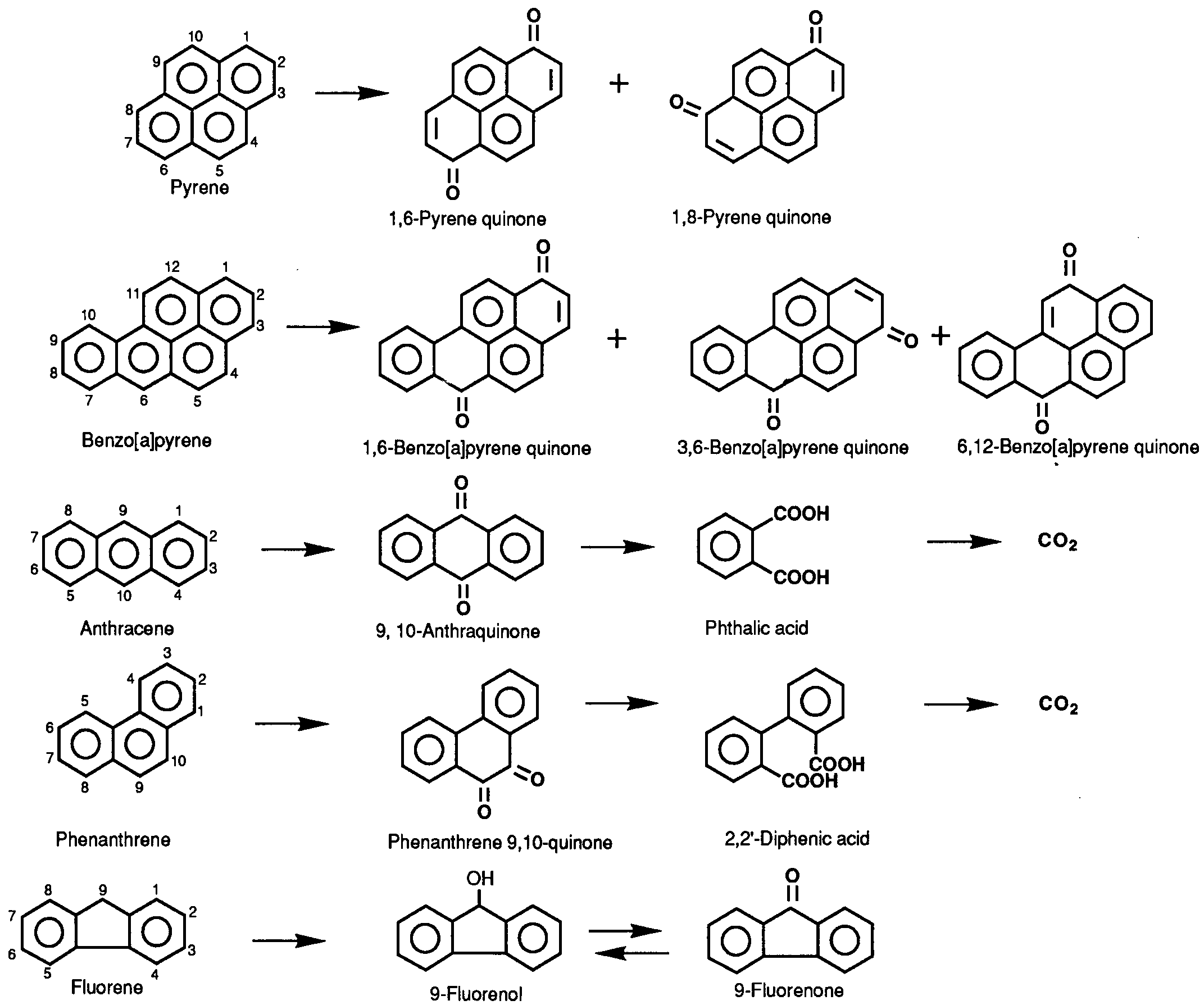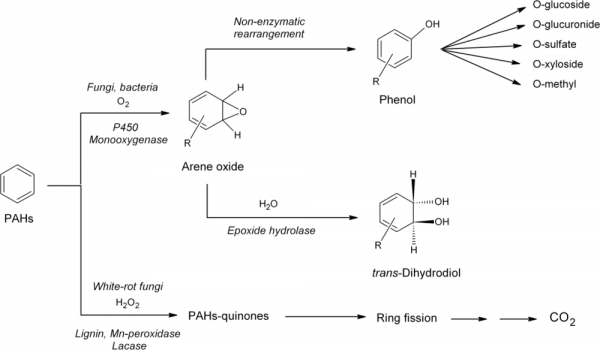From mycopedia
(→Non - ligninolytic fungi) |
|||
| (5 intermediate revisions by one user not shown) | |||
| Line 3: | Line 3: | ||
|} | |} | ||
| − | Polycyclic aromatic hydrocarbons (PAHs), also known as poly-aromatic hydrocarbons or polynuclear aromatic hydrocarbons, are potent atmospheric pollutants that consist of fused aromatic rings and do not contain heteroatoms or carry substituents. Naphthalene is the simplest example of a PAH. PAHs occur in oil, coal, and tar deposits, and are produced as byproducts of fuel burning (whether fossil fuel or biomass). As a pollutant, they are of concern because some compounds have been identified as carcinogenic, mutagenic, and teratogenic. PAHs are also found in cooked foods. Studies have shown that high levels of PAHs are found, for example, in meat cooked at high temperatures such as grilling or barbecuing, and in smoked fish. They are also found in the interstellar medium, in comets, and in meteorites and are a candidate molecule to act as a basis for the earliest forms of life. | + | Polycyclic aromatic hydrocarbons (PAHs), also known as poly-aromatic hydrocarbons or polynuclear aromatic hydrocarbons, are potent atmospheric pollutants that consist of fused aromatic rings and do not contain heteroatoms or carry substituents. Naphthalene is the simplest example of a PAH. PAHs occur in oil, coal, and tar deposits, and are produced as byproducts of fuel burning (whether fossil fuel or biomass). As a pollutant, they are of concern because some compounds have been identified as carcinogenic, mutagenic, and teratogenic. PAHs are also found in cooked foods. Studies have shown that high levels of PAHs are found, for example, in meat cooked at high temperatures such as grilling or barbecuing, and in smoked fish. They are also found in the interstellar medium, in comets, and in meteorites and are a candidate molecule to act as a basis for the earliest forms of life. |
| Line 23: | Line 23: | ||
== Non - ligninolytic fungi == | == Non - ligninolytic fungi == | ||
| − | |||
| − | |||
| − | |||
| − | |||
| − | |||
| − | |||
| − | |||
| − | |||
| − | |||
| − | |||
| − | |||
| − | |||
| − | |||
| − | |||
| − | |||
| − | |||
| − | |||
| − | |||
| − | |||
{|border="1" cellpadding="5" cellspacing="0" | {|border="1" cellpadding="5" cellspacing="0" | ||
|- | |- | ||
| Line 64: | Line 45: | ||
| − | + | Reference | |
Potential of Penicillium Species in the Bioremediation | Potential of Penicillium Species in the Bioremediation | ||
==Ligninolytic fungi(nutrient-limited) == | ==Ligninolytic fungi(nutrient-limited) == | ||
| − | + | Lignolytic fungi degrade PAHs trough non specific radical oxidation by Extracellular lignolytic enzymes. | |
| − | + | ||
* Extracellular lignolytic enzyme | * Extracellular lignolytic enzyme | ||
::*[[Lignin peroxidase]] | ::*[[Lignin peroxidase]] | ||
| Line 81: | Line 61: | ||
[[file:Ligninolytic fungi.png| 600px]] | [[file:Ligninolytic fungi.png| 600px]] | ||
| − | + | reference :Fungal metabolism of polycyclic aromatic hydrocarbons: past, | |
present and future applications in bioremediation | present and future applications in bioremediation | ||
| − | === | + | === Known species === |
* ''Phanerochaete chrysosprium'' | * ''Phanerochaete chrysosprium'' | ||
Latest revision as of 16:31, 8 April 2013
|
Polycyclic aromatic hydrocarbons (PAHs), also known as poly-aromatic hydrocarbons or polynuclear aromatic hydrocarbons, are potent atmospheric pollutants that consist of fused aromatic rings and do not contain heteroatoms or carry substituents. Naphthalene is the simplest example of a PAH. PAHs occur in oil, coal, and tar deposits, and are produced as byproducts of fuel burning (whether fossil fuel or biomass). As a pollutant, they are of concern because some compounds have been identified as carcinogenic, mutagenic, and teratogenic. PAHs are also found in cooked foods. Studies have shown that high levels of PAHs are found, for example, in meat cooked at high temperatures such as grilling or barbecuing, and in smoked fish. They are also found in the interstellar medium, in comets, and in meteorites and are a candidate molecule to act as a basis for the earliest forms of life.
- PAHs 의 구조
wikipedia:http://en.wikipedia.org/wiki/Polycyclic_aromatic_hydrocarbon
[edit] Metabolism
[edit] Non - ligninolytic fungi
| Class | Genus |
| Zygomycetes | cunninghamella blakesleeana , M verrucosa |
| C.ehinulata ,Mucor racemosus | |
| C.elgans 외 3 Genus | |
| Ascomycetes | Cryphonectria parasitica ,Neurospora crassa 외 4 Genus |
| Blastomycetes | Candida krusei , Rhodotorula gutinis 외 5 Genus |
| Hyphomycetes | Aspergillus niger , Monosporium olivaceum 외 30 Genus |
| Coelomycetes | Cinnobolus cesatii , C,sporulosum 외 3 Genus |
Reference Potential of Penicillium Species in the Bioremediation
[edit] Ligninolytic fungi(nutrient-limited)
Lignolytic fungi degrade PAHs trough non specific radical oxidation by Extracellular lignolytic enzymes.
- Extracellular lignolytic enzyme
Oxidation of polycyclic aromatic hydrocarbons by Ligninolytic fungi

reference :Fungal metabolism of polycyclic aromatic hydrocarbons: past, present and future applications in bioremediation
[edit] Known species
- Phanerochaete chrysosprium
- Trametes versicolor
- Pleurotus ostreatus


